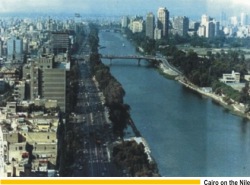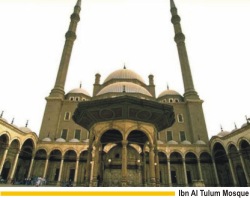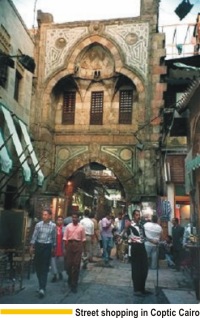Travel
An Egyptian
Travel Diary
Part I
Farhan
Quddus
 Flying
at 20,000 feet across the deserts of Qatar, heading over into
North Africa, the view down below is strange. Giant dark circles
resembling huge ink blotches litter the golden wasteland.
I assume these are dried-out oil fields, but from where I
am sitting they look like mysterious crop signs of the desert.
The mysteries of Egypt is already baffling me and we have
not even touched the soil yet! The captain announces that
we are 30 minutes from Cairo airport and I lean back on my
first class seat with a plate of "assorted mezze"
by my side. If ever a travel agent gets any perks at all in
this dreadful business that we are in, it's the free travel
and the "familiarisation" trips that we are rewarded
with once in a while; and this time around Qatar Airways Country
Manager is the generous host, taking ten agents and two airline
officials to explore this ancient land and the possibilities
of out bound tours from Bangladesh. Flying
at 20,000 feet across the deserts of Qatar, heading over into
North Africa, the view down below is strange. Giant dark circles
resembling huge ink blotches litter the golden wasteland.
I assume these are dried-out oil fields, but from where I
am sitting they look like mysterious crop signs of the desert.
The mysteries of Egypt is already baffling me and we have
not even touched the soil yet! The captain announces that
we are 30 minutes from Cairo airport and I lean back on my
first class seat with a plate of "assorted mezze"
by my side. If ever a travel agent gets any perks at all in
this dreadful business that we are in, it's the free travel
and the "familiarisation" trips that we are rewarded
with once in a while; and this time around Qatar Airways Country
Manager is the generous host, taking ten agents and two airline
officials to explore this ancient land and the possibilities
of out bound tours from Bangladesh.
Cairo
Airport is huge and old but bustling with tourists. Waiting
in an endless line at the immigration counter makes me want
to cry out for the luxury of ZIA International!! Once through
the customs, we collect our luggage and hold onto our possessions
fighting off porters and helpers until rescued by our tour
operator Ibrahim Bayoumi who helps us board the coach. Ahhh
Cairo! What a feeling. This is a real sense of achievement
as we start a 4-day tour of the city. Cairo: the "mother
of all civilizations"; a monster metropolis going back
1500 years. Cairo: the city of a 1,000 minarets. The ride
from the airport to our hotel is long but interesting as we
watch the evening's heavy traffic clog the streets. Cairo
is a city bursting at the seams. Densely populated with over
12 million people, driving in this city is one hand on the
horn and a fist waving out of the window!
 We
finally reach Zoser Partner Hotel, a five-star property on
the avenues of the pyramids, a busy touristy area. As we enter
the hotel, black uniformed commando-looking policemen check
our bags. They are intimidating, but it's comforting to know
that Egyptians mean business when it comes to fighting terrorism.
After the massacre of foreign tourists several years ago,
the Government cracked down on militants with a vengeance.
Before checking into our rooms Ibrahim chalks out the plan
of action for the evening and we are all going to an evening
dinner cruise on the Nile complete with whirling dervishes
and belly dancers. Egypt in March is chilly; in fact, it is
cold on the sidewalks of the Nile, where you will find hundreds
of these cruise riverboats with ushers hassling you to step
into "Five Star Nile Cruise Boats". March is peak
season and these boats don't wait long for tourists to cram
the decks. At any given moment you have over 100-300 boats
plying the river with blaring music and flickering lights
on deck. The view is absolutely gorgeous and festive. Cairo
comes to life when the sun sets! We
finally reach Zoser Partner Hotel, a five-star property on
the avenues of the pyramids, a busy touristy area. As we enter
the hotel, black uniformed commando-looking policemen check
our bags. They are intimidating, but it's comforting to know
that Egyptians mean business when it comes to fighting terrorism.
After the massacre of foreign tourists several years ago,
the Government cracked down on militants with a vengeance.
Before checking into our rooms Ibrahim chalks out the plan
of action for the evening and we are all going to an evening
dinner cruise on the Nile complete with whirling dervishes
and belly dancers. Egypt in March is chilly; in fact, it is
cold on the sidewalks of the Nile, where you will find hundreds
of these cruise riverboats with ushers hassling you to step
into "Five Star Nile Cruise Boats". March is peak
season and these boats don't wait long for tourists to cram
the decks. At any given moment you have over 100-300 boats
plying the river with blaring music and flickering lights
on deck. The view is absolutely gorgeous and festive. Cairo
comes to life when the sun sets!
On
board we watch a flamboyant MC take the mike and break into
Frank Sinatra songs the moment he spots a large group of American
tourists. Dinner is a buffet spread, much to my disappointment.
These cruises are commercial and the choice of food is definitely
for the western tourists - potato salad, beef stroganoff,
pasta, cold chicken slices with the token selection of hummus
and falafel is not my idea of Egyptian culinary extravaganza.
The MC introduces a man in a frock and tight pajamas wearing
a fez and a waistcoat. The band breaks into fast-tempo mid
eastern music and our "swirling" dervish starts
his gyrations! For those of you who have not witnessed a dancing
dervish before, this is probably the hardest way to make a
living, as you are likely to die of migraines or excess vomiting!!
Our fez-wearing friend starts to spin like a propeller at
speeds not humanly possible. The man's frock blossoms into
a parachute; threatening to take off and whiz away like a
chopper. At one point I am about to leap forward and tie him
down with a rope just so that I won't spill my dinner all
over everybody!! The dervish leaves with a thunderous applause
and a sigh of relief and the "star" of the show
walks onto center stage. "Miss Laila" takes the
stage with the glamour and finesse worthy of a Hollywood screen
diva. Belly dancers are huge celebrities in Egypt; this art
form is highly respected. She has the crowd eating from her
hand. Sheepish looking husbands and boyfriends nervously smile
as she dances around them undulating her voluptuous body like
a snake, dazzled by this enchanting woman sporting an emerald
on her navel! Perfectly timed, the boat slows down and anchors
on the jetty just around the time our belly dancer blows air
kisses and bows to the guests before running off into the
night. Three hours of heavy-duty entertainment on the Nile…
 Next
morning, the conversation at breakfast is more about the finer
art of belly dancing than the splendors of the pyramids, temples
and museums. Huddled around tables we sit with our steaming
bowls of "fuul medammes" (a thick hearty chick-pea
stew with slivers of meat and spices), plates of feta cheese
and olives while "Brother Ibrahim" briefs us of
the day's plans. It is a glorious Friday morning on the avenues
of the Pyramids and our first destination is the Cairo Museum,
but since we are all up bright and early and the museum doesn't
open till 10, we decide to board our bus and go to the banks
of the Nile. The cruise boats are all lined up on the side,
in a few hours the engines will be roaring again to take visitors
along the river. It's 9:30 am and all is quiet and peaceful
here as the oldest city in the world sleeps during the weekly
holiday. Next
morning, the conversation at breakfast is more about the finer
art of belly dancing than the splendors of the pyramids, temples
and museums. Huddled around tables we sit with our steaming
bowls of "fuul medammes" (a thick hearty chick-pea
stew with slivers of meat and spices), plates of feta cheese
and olives while "Brother Ibrahim" briefs us of
the day's plans. It is a glorious Friday morning on the avenues
of the Pyramids and our first destination is the Cairo Museum,
but since we are all up bright and early and the museum doesn't
open till 10, we decide to board our bus and go to the banks
of the Nile. The cruise boats are all lined up on the side,
in a few hours the engines will be roaring again to take visitors
along the river. It's 9:30 am and all is quiet and peaceful
here as the oldest city in the world sleeps during the weekly
holiday.
After
a series of group photos on the Nile, we reach the Cairo Museum
and realise why the rest of the city is so quiet; everybody
and everybody is here!! Hundreds of busloads of tourists wearing
brightly colored tour-group tokens on their clothing clamor
around the closed gates of the Cairo Museum. Our guide Yasser
has friends at the security gate and we are herded in through
the crowds to the Gardens of the Museum. Cairo Museum has
not lost its façade since the days of Howard Carter
and his partners who discovered the Tomb of Tut en Khamon.
Yasser is a graduate of Egyptology and a licensed guide, speaks
four languages and can answer any question you may have on
Egypt and anything else that is of importance. He tells us
that it takes four years to graduate from University with
this degree and there are internships to be done. Herding
tourists around is not as easy a task as it looks, and we
understand why when we enter the
 Museum.
Each group must have a tour leader and they systematically
start to cover this ancient building from bottom to top. The
trail is like a train network, one group moves on to the next
exhibit and the second takes that place. Yasser explains how
most of the priceless Egyptian exhibits are now housed in
London or Paris thanks to colonialism and ignorance on the
part of the Egyptian authorities. There was a time in the
late 19th and early 20th century when one could dig the ground
in Egypt and walk away with whatever they could get their
hands on. In the case of "Nefertiti", there is not
one priceless bust remaining in Egyptian custody. The most
popular bust which has replicas around the world is actually
in Germany! Museum.
Each group must have a tour leader and they systematically
start to cover this ancient building from bottom to top. The
trail is like a train network, one group moves on to the next
exhibit and the second takes that place. Yasser explains how
most of the priceless Egyptian exhibits are now housed in
London or Paris thanks to colonialism and ignorance on the
part of the Egyptian authorities. There was a time in the
late 19th and early 20th century when one could dig the ground
in Egypt and walk away with whatever they could get their
hands on. In the case of "Nefertiti", there is not
one priceless bust remaining in Egyptian custody. The most
popular bust which has replicas around the world is actually
in Germany!
Cairo
Museum is huge and one needs four hours of concentration,
good walking shoes, plenty of water and an open mind to take
in so much information. After two hours of being ushered into
room after room, climbing stairs, walking through corridors,
I give up the tour with the pretext that my hip problem is
acting up and I need to rest. The place is so gigantic that
I lose my way and I ask a "friendly" attendant for
directions to the exit. He walks me eight steps to the left
and shows me the stairs and the exit and asks for "baksheesh"
with palm stretched! I smile at him, take his hand and warmly
shake it, pat him on the back, wink and walk off …feigning
lack of comprehension and an unstable mind. Cairo is notorious
for "baksheesh seekers" and one has to be careful
and a little smart to tackle the street vendors and guides.
This is "Price-Haggling City" and the tourists coming
in must at all times, keep a calculator. Asking prices must
be cut down by 80 % on the first phase of the negotiations
and judging on the insistence of the vendor, one can take
off another 10 % on the second phase of the transactions.
One should not feel bad, because the vendor will still make
lots of money and have enough to pay the middle men who will
take you on the shopping excursions!
 The
Citadel is this afternoon's first destination before going
for Friday prayers and the driver will be driving us through
"Coptic Cairo", the oldest quarter of the city.
This 900 year-old Muslim fortress with its 100ft walls was
built to protect its mosques from the Crusaders. The
Citadel is this afternoon's first destination before going
for Friday prayers and the driver will be driving us through
"Coptic Cairo", the oldest quarter of the city.
This 900 year-old Muslim fortress with its 100ft walls was
built to protect its mosques from the Crusaders.
Its main
attraction is the Mohammed Ali Mosque with its unbelievable
exterior and interior. The fortress sits on a hill, which
allows great photo opportunities and 360-degree view of Cairo.
Our enthusiastic guide is on a roll as he decides to take
us for another short excursion to the entrance of the "city
of the dead", an amazing district of Cairo where the
"living live over and amongst the dead". This quarter
is a labyrinth of houses built around and amongst tombs and
mausoleums, which defies all laws of architecture. We don't
have time to get down and follow the guided tour through this
area but the feeling is eerie. We finally make it to the ancient
mosque of "Al Azhar" and Friday congregation is
a sea of devotees. The Al-Azhar Mosque (the most blooming)
was established in 972 (361 H) after the founding of Cairo
itself. Located in the centre of an area teeming with the
most beautiful Islamic monuments from the 10th century, it
was called "Al-Azhar" after Fatama al-Zahraa, daughter
of the Prophet Mohammed (Peace Be Upon Him).
The second
and concluding part of this travel piece will be published
next week
Copyright
(R) thedailystar.net 2004
|
| |
